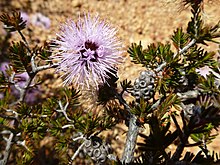Beaufortia schaueri
| Pink bottlebrush | |
|---|---|

| |
| Scientific classification | |
| Kingdom: | Plantae |
| Clade: | Tracheophytes |
| Clade: | Angiosperms |
| Clade: | Eudicots |
| Clade: | Rosids |
| Order: | Myrtales |
| Family: | Myrtaceae |
| Genus: | Beaufortia |
| Species: | B. schaueri
|
| Binomial name | |
| Beaufortia schaueri | |
| Synonyms[1] | |
| |

Beaufortia schaueri, commonly known as pink bottlebrush[2] or pink beaufortia,[3] is a species of flowering plant in the myrtle family, Myrtaceae and is endemic to the southwest of Western Australia. It is a small, rounded shrub with small, crowded, linear leaves and profuse, spherical heads of pink flowers conspicuously displayed on the ends of the branches in spring.
Description[edit]
Beaufortia schaueri is a small, compact shrub which grows to a height of about 1.5 metres (5 ft). The leaves are arranged in alternating pairs (decussate) so that they make four rows along the stems. The leaves are about 10 millimetres (0.4 in) long, linear in shape, overlap each other and are triangular to almost circular in cross section.[2][3][4]
The flowers are bright pink to mauve and are arranged in almost spherical heads on the ends of branches which continue to grow after flowering. The flowers have 5 sepals, 5 petals and 5 bundles of stamens. There are usually 5 stamens in a bundle and they are joined for about half their length. Flowering occurs from September to December and is followed by fruits which are woody capsules.[2][3][4][5]
Taxonomy[edit]
Beaufortia schaueri was first formally described in 1843 by Johannes Conrad Schauer in Dissertatio phytographica de Regelia, Beaufortia et Calothamno from an unpublished description by Balthazar Preiss.[6] The specific epithet (schaueri) honours Schauer.[7]
Distribution and habitat[edit]
Beaufortia schaueri occurs mainly between the Albany and Israelite Bay districts in the Avon Wheatbelt, Coolgardie, Esperance Plains, Jarrah Forest and Mallee bioregions of south-western Western Australia.[3] It usually grows in sandy soils or those derived from laterite on plains and slopes.[8]
Conservation[edit]
Beaufortia schaueri is classified as "not threatened" by the Western Australian government Department of Parks and Wildlife.[3]
References[edit]
- ^ a b "Beaufortia schaueri". Australian Plant Census. Retrieved 5 October 2020.
- ^ a b c "Beaufortia schaueri". Australian Native Plants Society (Australia). Retrieved 24 August 2015.
- ^ a b c d e "Beaufortia schaueri". FloraBase. Retrieved 24 August 2015.
- ^ a b Archer, William. "Beaufortia schaueri - Pink Bottlebrush". Esperance Wildflowers. Retrieved 24 August 2015.
- ^ Corrick, Margaret G.; Fuhrer, Bruce A. (2009). Wildflowers of Southern Western Australia (3rd ed.). Kenthurst, N.S.W.: Rosenberg Pub. p. 113. ISBN 9781877058844.
- ^ "Beaufortia schaueri". APNI. Retrieved 24 August 2015.
- ^ Sharr, Francis Aubi; George, Alex (2019). Western Australian Plant Names and Their Meanings (3rd ed.). Kardinya, WA: Four Gables Press. p. 302. ISBN 9780958034180.
- ^ Paczkowska, Grazyna; Chapman, Alex R. (2000). The Western Australian flora : a descriptive catalogue. Perth: Wildflower Society of Western Australia. p. 349. ISBN 0646402439.
